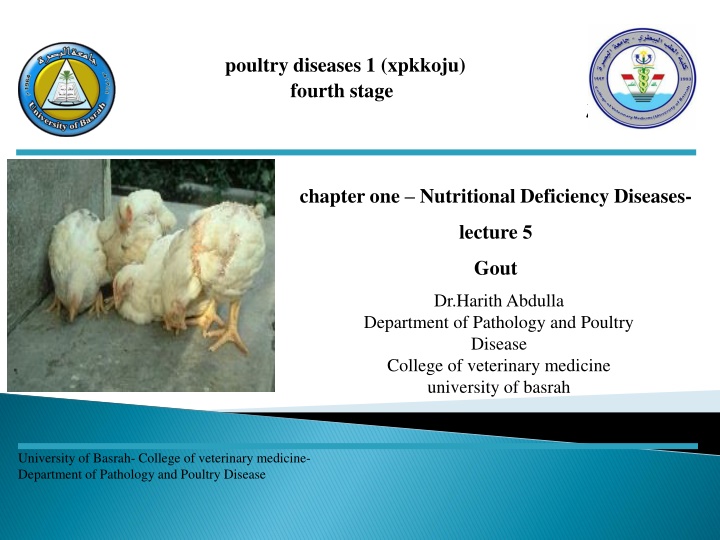
Nutritional Deficiency Diseases in Poultry: Gout and Ascites
Explore the nutritional deficiency diseases affecting poultry, including gout and ascites. Learn about the causes, symptoms, and preventive measures to safeguard the health of poultry birds. Discover insights from Dr. Harith Abdulla at the University of Basrah and gain valuable knowledge to manage poultry diseases effectively.
Download Presentation

Please find below an Image/Link to download the presentation.
The content on the website is provided AS IS for your information and personal use only. It may not be sold, licensed, or shared on other websites without obtaining consent from the author. If you encounter any issues during the download, it is possible that the publisher has removed the file from their server.
You are allowed to download the files provided on this website for personal or commercial use, subject to the condition that they are used lawfully. All files are the property of their respective owners.
The content on the website is provided AS IS for your information and personal use only. It may not be sold, licensed, or shared on other websites without obtaining consent from the author.
E N D
Presentation Transcript
poultry diseases 1 (xpkkoju) fourth stage chapter one Nutritional Deficiency Diseases- lecture 5 Gout Dr.Harith Abdulla Department of Pathology and Poultry Disease College of veterinary medicine university of basrah University of Basrah- College of veterinary medicine- Department of Pathology and Poultry Disease
Is a nutritional disease characterized by deposits of sodium urates. It occur in two forms, visceral and articular gout. In both the forms, deposits consist of chalky white materials. Visceral gout is considered to be acute form and is more insidious and difficult to detect in early stages or in live birds.
1- High protein diets. 2-Vitamin A deficiency. 3-Abnormality which impairs kidney function. 4-Insufficient water intake .
1- Age : Any age . 2-Forms: Articular form, Visceral form. Lesions: 1-Sodium urates may deposit in any visceral organ. 2-Kidneys are enlarged, light in color, and spotted with urates. 3-The ureters are enlarged and packed with urates. 4- The heart is often affected. Lesions:
1-Plenty of water. 2-Low protein diet.
Ascites is a disease of broiler chickens occurs especially at high altitude characterized by an accumulation of transudate in the peritoneal cavity or pericardial sac. The fluid, may contain yellow protein clots.
B.P.H.S. [Broiler Pulmonary Hypertension Syndrome] . High Altitude Disease. Edema Disease. Heart Failure Syndrome. Dropsy .
Predisposing factors includes: 1-Reduced ventilation. 2- High altitude. 3- Respiratory disease. Predisposing factors includes: Morbidity: Morbidity: Is usually 1-5% . Mortality: Mortality: 1-2% but can be 30% at high altitude.
1 1- -Sudden death 2 2- -Poor development. 3 3- -Progressive weakness and abdominal distension. 4 4- -Recumbency. 5 5- -Dyspnea. 6 6- -Possibly cyanosis. Sudden death in rapidly developing birds. Poor development. Progressive weakness and abdominal distension. Recumbency. Dyspnea. Possibly cyanosis. in rapidly developing birds.
1. Thickening of right 2. Dilation of the ventricle. 3. Thickening of atrioventricular valve. 4. Generalized congestion. 5. Liver enlargement. 6. Spleen is small. 7. Pericardial effusion. Thickening of right- -side myocardium. Dilation of the ventricle. Thickening of atrioventricular valve. Generalized congestion. Liver enlargement. Spleen is small. Pericardial effusion. side myocardium. 1. 2. 3. 4. 5. 6. 7.
1 1- -Signs. 2 2- -Lesions 3 3- -Cardiac specific protein (Troponin T) Signs. Lesions: Gross pathology is characteristic. Cardiac specific protein (Troponin T) may be measured in the blood. Gross pathology is characteristic. may be measured in the blood.
1 1- -Broiler Sudden Death Syndrome . 2 2- -Bacterial endocarditis. Broiler Sudden Death Syndrome . Bacterial endocarditis. Treatment: 1 1- -Improve ventilation. 2 2- -Vitamin C . Treatment: Improve ventilation. Vitamin C .
1 1- -Good ventilation (during incubation 2 2- - Avoid any genetic tendency. 3 3- - Control Good ventilation (during incubation and chick transport). Avoid any genetic tendency. Control respiratory diseases. and chick transport). respiratory diseases.
